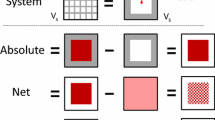Abstract
The densities and heat capacities of the first four members of the 2-n-alkoxyethanols were measured in water over the whole mole fraction range with a flow densimeter and a flow microcalorimeter. The methoxy and n-propoxy homologs were studied at 25°C, ethoxyethanol at 19, 25, and 40C, andn-butoxyethanol at 4, 10, 25, 40, and 55°C. While methoxyethanol behaves as a fairly typical polar nonelectrolyte in water,n-butoxyethanol shows trends in the concentration dependence which resemble micellization; some pseudo-microphase transition occurs at about 0.02 mole fraction, and this transition concentration decreases with increasing temperature. There is no simple relationship between this phenomenon and the existence of a lower critical solution temperature at 49°C since the sharpness of the thermodynamic changes is maximum at the lowest temperature and at 55°C the apparent molal quantities on both sides of the two-phase region appear to fall on the same continuous curve. In the region prior to the pseudo-microphase separation the apparent and partial molal heat capacities decrease regularly but beyond approximately 0.01 mole fraction increase sharply to a maximum, suggesting some type of pre-association. The apparent molal heat capacity of water in the binary solutions is larger than the molar heat capacity of water over the whole mole fraction range. The present data seem to be consistent with a clathrate model for hydrophobic hydration and interactions with these systems.
Similar content being viewed by others
References
J. E. Desnoyers, O. Kiyohara, and G. Perron,Adv. Chem. Ser. 155, 274 (1976).
C. de Visser, G. Perron, and J. E. Desnoyers,J. Am. Chem. Soc. 18, 5894, (1977).
C. de Visser, G. Perron, and J. E. Desnoyers,Can. J. Chem. 55, 586 (1977).
G. M. Musbally, G. Perron, and J. E. Desnoyers,J. Colloid Interface Sci. 48, 494 (1974).
P. Picker, E. Tremblay, and C. Jolicoeur,J. Solution Chem. 3, 377 (1974).
P. Picker, P. A. Leduc, P. R. Philip, and J. E. Desnoyers,J. Chem. Thermodyn. 3, 631 (1971).
J. E. Desnoyers, C. de Visser, G. Perron, and P. Picker,J. Solution Chem. 5, 605 (1976).
G. S. Kell,J. Chem. Eng. Data 12, 66 (1967).
H. F. Stimson,Am. J. Phys. 23, 614 (1955).
L. Cox and L. H. Cretcher,J. Am. Chem. Soc. 48, 451 (1926).
G. Poppe,Bull. Soc. Chim. Belg. 44, 640 (1935).
N. Chakhovskoy,Bull. Soc. Chim. Belg. 65, 476 (1956).
G. Schneider and O. Wilhelm,Z. Phys. Chem. (Frankfurt) 80, 219 (1959).
C. M. Ellis,J. Chem. Educ. 44, 405 (1967).
Von Y. Onken,Z. Elektrochem. 63, 321 (1959).
N. Chakhovskoy, R. H. Martin, and R. Van Wechel,Bull. Soc. Chim. Belg. 65, 453 (1956).
G. Scatchard and G. M. Wilson,J. Am. Chem. Soc. 86, 133 (1964).
K. Y. Chu and A. R. Thompson,J. Chem. Eng. Data. 5, 147 (1960).
L. McKinley and A. Nibarger,J. Am. Chem. Soc. 61, 373 (1939).
K. Kusano, J. Suurkuusk, and I. Wadsö,J. Chem. Thermodyn. 5, 757 (1973).
P. Picker, J. L. Fortier, M. A. Simard, and C. Jolicoeur, in preparation.
F. Franks and D. S. Reid, inWater A Comprehensive Treatise, F. Franks, ed., Vol. 2, Plenum Press, New York, (1973), Chap. 5.
G. Perron, N. Desrosiers, and J. E. Desnoyers,Can. J. Chem. 54, 2163 (1976).
O. Kiyohara, G. Perron, and J. E. Desnoyers,Can. J. Chem. 53, 3263 (1975).
O. Kiyohara, G. Perron, and J. E. Desnoyers,Can. J. Chem. 53, 2591 (1975).
C. de Visser, G. Perron, J. E. Desnoyers, W. J. M. Heuvelsland, and G. Somsen,J. Chem. Eng. Data 22, 74 (1977).
G. Roux, G. Perron, and J. E. Desnoyers, in preparation.
G. Roux, G. Perron, and J. E. Desnoyers,J. Phys. Chem. 82, 966 (1978).
G. Roux, G. Perron, and J. E. Desnoyers, unpublished results.
Micellization, Solubilization, and Microemulsions, K. L. Mittal, ed., Vols. 1 and 2 (Plenum Press, New York, 1977).
C. de Visser, W. J. M. Heuvelsland, L. A. Dunn, and G. Somsen,J. Chem. Soc. Faraday Trans. 1,74, 1159 (1978).
M. J. Blandamer, D. E. Clark, N. J. Hidden, and M. C. R. Symons,Trans. Faraday Soc. 64, 2691 (1968).
R. J. Fanning and P. Kruus,Can. J. Chem. 48, 2052 (1970).
K. Tamura, M. Maekawa, and T. Yasunaga,J. Phys. Chem. 81, 2122 (1977).
N. Muller,J. Magn. Reson. 28, 203 (1977).
K. Iwasaki and T. Fujiyama,J. Phys. Chem. 81, 1908 (1977).
S. Harada, T. Nakajima, T. Komatsu, and T. Nakagama,J. Solution Chem. 7, 463 (1978).
Author information
Authors and Affiliations
Rights and permissions
About this article
Cite this article
Roux, G., Perron, G. & Desnoyers, J.E. Model systems for hydrophobic interactions: Volumes and heat capacities ofn-alkoxyethanols in water. J Solution Chem 7, 639–654 (1978). https://doi.org/10.1007/BF00652015
Received:
Revised:
Issue Date:
DOI: https://doi.org/10.1007/BF00652015




